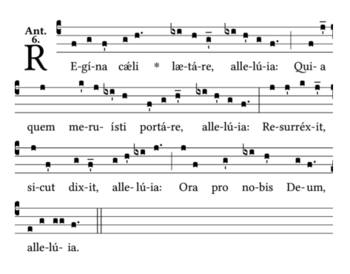Regina caeli
"Regina caeli" (Ecclesiastical Latin: [reˈdʒina ˈtʃeli]; English: Queen of Heaven) is a musical antiphon addressed to the Blessed Virgin Mary that is used in the liturgy of the Roman Rite of the Catholic Church during the Easter season, from Easter Sunday until Pentecost. During this season, it is the Marian antiphon that ends Compline (Night Prayer)[2] and it takes the place of the traditional thrice-daily Angelus prayer.

In the past, the spelling "Regina coeli" was sometimes used,[3] but this spelling is no longer found in official liturgical books.
| Part of a series on the |
| Mariology of the Catholic Church |
|---|
 Virgo by Josef Moroder-Lusenberg |
|
|
|
|
|
|
Text
The antiphon itself consists of four lines:
|
Regina caeli, laetare, alleluia; |
Queen of heaven, rejoice, alleluia. |
Compline, as revised in 1969 after the Second Vatican Council, ends with the antiphon alone. In the earlier Roman Breviary and in recitation at Angelus time during Eastertide, the following versicle (℣) and response (℟) and the following prayer are added to the antiphon:
|
℣. Gaude et laetare, Virgo Maria, alleluia. |
℣. Rejoice and be glad, O Virgin Mary, alleluia. |
A verse translation in 7.7.7.7 metre used in some Anglican churches is usually sung to the hymn tune known as Easter Hymn, "Christ the Lord is Risen Today" or the hymn tune "Ave Virgo Virginum" (Hail Virgin of virgins):
- ℣. Joy to thee, O Queen of Heaven. Alleluia!
- ℟. He whom Thou wast meet to bear. Alleluia!
- ℣. As He promised hath arisen. Alleluia!
- ℟. Pour for us to God thy prayer. Alleluia!
- ℣. Rejoice and be glad, O Virgin Mary, alleluia.
- ℟. For the Lord is risen indeed, alleluia.
- Let us pray:
- O God, who through the resurrection of Thy Son our Lord Jesus Christ didst vouchsafe to give joy to the world: grant, we beseech thee, that through His Mother, the Virgin Mary, we may obtain the joys of everlasting life. Through Christ our Lord. ℟. Amen.

History
The authorship of the Regina caeli is unknown. It has been traced back to the 12th century and is found in an antiphonary of about 1200 now in St Peter's Basilica, Rome.[6] In the first half of the 13th century it was in Franciscan use, after compline.
Jacobus da Varagine's thirteenth-century Golden Legend includes a story that, during a procession with an image of the Blessed Virgin that was held to pray for the ending of a pestilence in Rome, angels were heard singing the first three lines of the Regina caeli antiphon, to which Pope Gregory the Great (590−604) thereupon added the fourth, after which he saw atop what in consequence is called the Castel Sant'Angelo a vision of an angel sheathing his sword, thus signifying the cessation of the plague.[7]

Polyphonic settings
As well as the plainsong melodies (a simple and an ornate form) associated with it, the Regina caeli has since the 16th century often been provided with polyphonic settings.[8] Pierre de Manchicourt's setting is of 1539.[9] A setting for four voices by Charles de Courbe dates from 1622,[10] and Lully's motet "Regina coeli, laetare" is of 1684. 5 Regina caeli, H 16, H 30, H 32, H 46, H 31 (1670 - 1680) have been composed by Marc-Antoine Charpentier. There are three settings by the young Mozart (K.108, K.127, and K.276), and one by Brahms (Op. 37 #3).
References
- The Regina caeli sung
- "Finally one of the antiphons of the Blessed Virgin Mary is said. In Eastertide this is always the Regina caeli" (General Instruction of the Liturgy of the Hours, 92).
- Cf. Eugen Rosenstock-Huessy, Ford Lewis Battles, Magna Carta Latina (Argo Books 1975), p. 149
- Loyola Press: Regina Caeli
- Roman Missal, Common of the Blessed Virgin Mary, IV. In Easter Time
- Wolfgang Breitschneider, "Marianische Antiphonen" in Walter Kasper (ed.), Lexikon für Theologie und Kirche (third edition), volume 6 (Herder, Freiburg im Breisgau 1997), 1358
- Jacobo de Vorágine, The Golden Legend: Readings on the Saints, Volume 1 (Princeton University Press 1995), p. 174
- An unidentified polyphonic setting
- Regina coeli laetare (Manchicourt,_Pierre_de)
- Cantiques spirituels nouvellement mis en musique à IIII, V, VI, VIIet VIII parties par le Sr de Courbes, Paris, Pierre Ballard ed. 1622.(F-Pn Rés. Vm7. 273
External links
| Wikimedia Commons has media related to Regina Coeli. |
